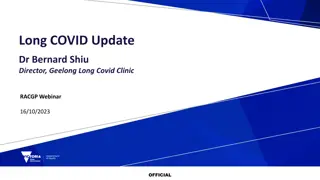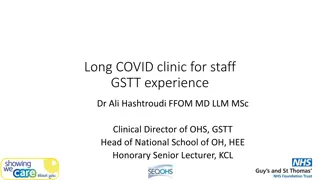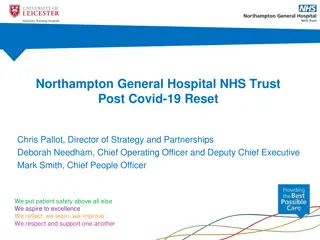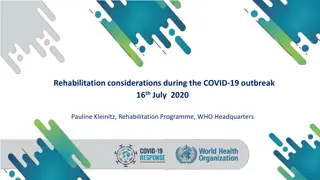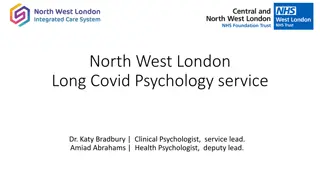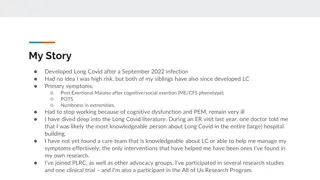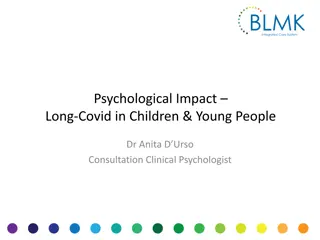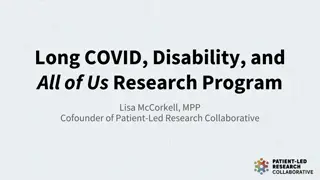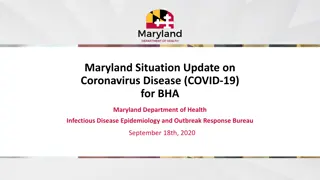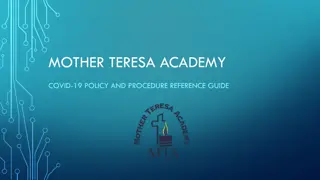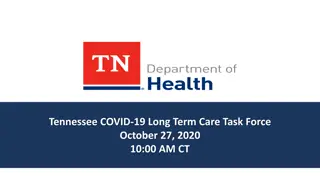Understanding Long Covid: Overview and Case Discussion
Long Covid, also known as post-Covid condition, refers to persistent symptoms lasting at least 2 months after the initial Covid-19 infection. Symptoms can include fatigue, shortness of breath, and cognitive dysfunction, impacting daily life. Around 10-30% of Covid patients may experience Long Covid, with common issues like mental health concerns. Management involves symptomatic care, pacing activities, graded exercise therapy, and addressing mental health needs. A case study at Makoi Health Care highlighted symptoms like fatigue, palpitations, and mental health struggles in affected individuals.
Download Presentation

Please find below an Image/Link to download the presentation.
The content on the website is provided AS IS for your information and personal use only. It may not be sold, licensed, or shared on other websites without obtaining consent from the author. Download presentation by click this link. If you encounter any issues during the download, it is possible that the publisher has removed the file from their server.
E N D
Presentation Transcript
Long Covid Brief Overview and Case discussion Dr Attishay C Prasad General Practitioner Makoi Health Care 1
Acknowledgment: Dr Ravi Naidu Department of Internal Medicine CWM Hospital 2
What is Long Covid Long COVID is a patient-created term which was reportedly first used in May 2020 as a hashtag on Twitter by Elisa Perego, an archaeologist at University College London Initial recognitions of this syndrome was largely patient driven. (Callard & Perego, 2021) Recent WHO Case definition: Post COVID-19 condition occurs in individuals with a history of probable or confirmed SARS-CoV-2 infection, usually 3 months from the onset of COVID-19 with symptoms that last for at least 2 months and cannot be explained by an alternative diagnosis. Common symptoms include fatigue, shortness of breath, cognitive dysfunction but also others (see Table 3 and Annex 2) which generally have an impact on everyday functioning. Symptoms may be new onset, following initial recovery from an acute COVID- 19 episode, or persist from the initial illness. Symptoms may also fluctuate or relapse over time. A separate definition may be applicable for children (WHO Team, WHO HQ, 2021) 3
Lopez-Leon et al., More than 50 Long-Term Effects of COVID-19. 4
Long Covid Affects 10% to 30% of people with covid In Fiji this means 5247 to 15740 people Symptom relapse in 85% of people after physical or mental exertion or stress. (Davis et al., 2021) Mental health issues are common and should be addressed 5
Management Symptomatic management Use of antimicrobials and steroids only if indicated Pacing: Rest when tired Active when able Prioritisation of energy expenditure Graded Exercise Therapy (GET) Afternoon exercise, sunlight exposure promotes good sleep. If SOB, ensure patient can speak in phrases. If Fatigue, aim for < 60% max HR. Endurance before Intensity Cognitive Behavioral Therapy (CBT) For mental health issues 6
Long Covid caseload in Makoi Health Care 14 cases seen from July to October Most commonly presenting at 3 months after clearance/resolution of Majority of Covid symptoms 8 female 6 male Age range 23 years to 56 years (Median 41 years) 12 in full-time employment/education Most common complaint Fatigue (10), Palpitations (2), Anosmia (1), Headache (1) New onset diabetes in 2 patients Exacerbations commonly related to overwork/ socio occupational expectations Mental health issues present in all patients ranging from self-doubt and moderate anxiety to Moderate-Severe depression 7
Case 1 32 year old female secondary school teacher. Covid positive in May 2021. Fever, weakness, shortness of breath and fatigue After clearance: persistent fatigue. Not able to cook or do other chores Presented in August Stress and anxiety, feeling something is wrong with her because other family members have recovered fully 8
Case 1 Was overworked during family gathering during lockdown! Afterwards having depressive features: insomnia Low mood and irritability with aggressive out bursts (worsening) lack of energy Anxiety/neurosis (mild Agoraphobia) Low self-esteem and confidence about meeting family responsibilities and teaching obligations. Family also concerned Vital signs Normal 9
Case 1- management Reassured, feelings validated Educated on long covid Brief psychotherapy done Short course of benzodiazepines Advised to step back from responsibilities- medical certificate written Blood workup done - normal findings Weekly review 10
Case 1 Management (2) At 1st review, nil significant improvement Changed to amitriptyline (to better manage insomnia) Continued psychotherapy: CBT based and gradual exposure Reassurance, that there will be gradual improvement At 2nd review, improvement noted, Managing limited energy Introduced GET, Pacing Slow but steady improvement seen Gradual return to household and employment responsibilities Facilitation of above via medical certificates 11
Case 2 43 year old male warehouse supervisor Symptomatic covid with positive NPS June 2021 Persistent fatigue after recovery/clearance Cannot walk to bathroom initially At presentation in August able to walk out of home but not reach end of short driveway Concern that he may have heart issue and may have to give up employment Came with results of blood and imaging workups that were normal apart from elevated fasting sugar Random blood sugar test also elevated 12
Case 2 HbA1c confirmed development of diabetes Commenced on oral anti-hyperglycemics Educated on lifestyle changes Above advice combined with education and reassurance re Long Covid symptoms GET and pacing introduced Regular reviews Slow and steady improvement noted Gradual return to full duties, medical certificates issued to facilitate workplace adjustments. 13
Case 3 23 year old admin clerk (single, lives with her family) Complaints of easy fatigability after covid. Presented at 6 months Had already been pacing naturally Worked up Reassurance Introduced GET 14
Summary 3 different presentations Patient-perceived morbidity depends on prior level of socio occupational functioning Treatment is individualised but underlying principles are same Supportive and symptomatic treatment Reassurance and validation Mental health dimension addressed Investigate to rule out other conditions (diagnosis of exclusion) Negotiation with employers to facilitate gradual return to full duties 15
References Callard, Felicity, and Elisa Perego. How and Why Patients Made Long Covid. Social Science & Medicine (1982) 268 (January 2021): 113426. https://doi.org/10.1016/j.socscimed.2020.113426. Davis, Hannah E., Gina S. Assaf, Lisa McCorkell, Hannah Wei, Ryan J. Low, Yochai Re em, Signe Redfield, Jared P. Austin, and Athena Akrami. Characterizing Long COVID in an International Cohort: 7 Months of Symptoms and Their Impact. EClinicalMedicine 38 (August 2021): 101019. https://doi.org/10.1016/j.eclinm.2021.101019. Lopez-Leon, Sandra, Talia Wegman-Ostrosky, Carol Perelman, Rosalinda Sepulveda, Paulina A. Rebolledo, Angelica Cuapio, and Sonia Villapol. More than 50 Long-Term Effects of COVID-19: A Systematic Review and Meta-Analysis. Scientific Reports 11, no. 1 (December 2021): 16144. https://doi.org/10.1038/s41598-021-95565-8. Nurek, Martine, Clare Rayner, Anette Freyer, Sharon Taylor, Linn J rte, Nathalie MacDermott, and Brendan C. Delaney. Recommendations for the Recognition, Diagnosis, and Management of Patients with Post COVID-19 Condition ('Long COVID ): A Delphi Study. SSRN Electronic Journal, 2021. https://doi.org/10.2139/ssrn.3822279. WHO Team, WHO HQ. A Clinical Case Definition of Post COVID-19 Condition by a Delphi Consensus. World Health Organisation, October 6, 2021. https://www.who.int/publications-detail-redirect/WHO-2019-nCoV-Post_COVID-19_condition- Clinical_case_definition-2021.1. 16



